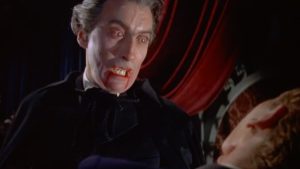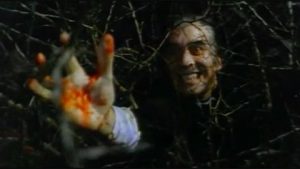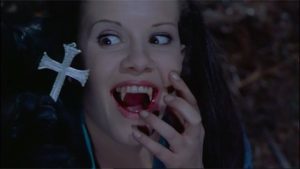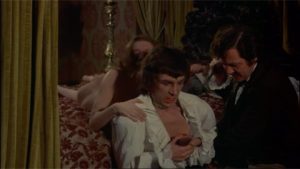
The Hammer vampire is a complicated creature, so complicated that it would really be quite difficult to recognise one, let alone know what to do with it. Let’s examine the situation in more detail.
In Dracula (1958), things were comparatively simple. A vampire is obviously an undead human which has to sleep in its tomb or in its native earth during daylight hours, issuing forth only at night to drink the blood of its victims, who, if they die, then become vampires themselves. We are also told by Peter Cushing’s Van Helsing, dictating into his phonograph, details of things which will repel a vampire – “One, light. The vampire allergic to light; never ventures forth in the daytime; sunlight fatal, repeat fatal; would destroy them. Two, garlic. Vampires repelled by the odour of garlic. Three, the crucifix, symbolising the power of good over evil. The power of the crucifix in these cases……is twofold. It protects the normal human being, but reveals the vampire, or victim of this vile contagion when in advanced stages.”

In the same film, we also see that a vampire can be destroyed by a stake driven through the heart and that the touch of a crucifix sears the flesh or the vampire or its victims. Moreover, we learn that a vampire cannot turn itself into a bat or wolf. When Arthur Holmwood (Michael Gough) suggests otherwise, Van Helsing’s reply is unequivocal – “That’s a common fallacy,” he states authoritatively.
So far so good.
In their very next vampire film, The Brides of Dracula”(1960), Hammer immediately began to move the goalposts. There is of course nothing wrong with doing this, cinematically speaking, and Universal had done similar things with their own horror series in the thirties and forties, but it’s interesting anyway to see the changes develop. In “Brides”, for instance, Van Helsing contradicts his statement in the original film, telling the Priest (Fred Johnson) that some vampires “have the power to transform themselves into bats” and offering burning as an alternative method of destroying the undead. We also see that holy water burns the vampire and getting caught in a cross-shaped shadow doesn’t do him much good either! Incidentally, in this film Van Helsing observes that “the vampire, by its kiss, the taking of blood from its victim, makes of that victim another victim – so the cult grows, infinitely slowly, but it grows.” The choice of the words “infinitely slowly” seems a little strange, given that if each vampire creates other vampires at the rate of just one a night, then the entire planet would be overrun with the undead in under a month!

After “Brides” came Kiss of the Vampire (1963), which dispelled the idea that vampires cannot move around in daylight, but merely have to avoid bright sunlight. This is best demonstrated by the scene in which, when Professor Zimmer (Clifford Evans) points out to Carl (Barry Warren) and Sabena (Jacquie Wallis) that the gloomy weather seems to be improving, they immediately rush home to the dark security of their castle, where they are later destroyed by a swarm of bats conjured up in a ritualistic ceremony performed by the Professor, another twist to the legend.
Next in Dracula – Prince of Darkness (1966), we are asked to believe that a vampire can be resurrected, despite its “final and absolute destruction” (the words used by Andrew Keir as narrator of the film’s prologue) and another weapon is added to the vampire-hunter’s arsenal – immersion in running water, a method of disposal used again on Christopher Neame’s Johnny Alucard in Dracula A.D. 1972 (more of which later). However, a more controversial turn to the myth was presented in Dracula has Risen from the Grave (1968). Here, having convinced audiences of the possibility of reviving a destroyed vampire, Hammer probably went a bit too far by insisting (for one film only) that a stake through the heart would only work if accompanied by the prayers of a true believer! The idea failed, not so much because it was something new, but more because we were being asked to alter our belief in a basic tenet – namely that a staked vampire really has met his Waterloo, prayers or not, (unless later resurrected, of course!). This was the argument put forward by Christopher Lee when he tried to have the scene amended, but he was overruled and it remains in the film.
The rest of the Hammer “Dracula” series remains quite consistent. He is revived and destroyed in reasonably acceptable ways: entrapment in a church (Taste the Blood of Dracula) , burned (Scars of Dracula) and staked (Dracula A.D.1972 and The Satanic Rites of Dracula). Similarly, the other vampires in these films get their comeuppance by traditional (Hammer) means, with the possible exception of the vampire girls in the cellar in “Satanic Rites”, where we are required to make a leap of imagination and substitute water sprinklers for immersion in running water! Other weapons also came along in these later productions, notably the silver knife in Dracula A.D. 1972 (by now we have been informed that vampires do not like silver either) and the hawthorn tree in “Satanic Rites”, abhorrent to the vampire because it “provided Christ with His crown of thorns”.

Dracula entangled in the hawthorn bush
Probably the greatest twist of all to the Dracula legend, however, came in The Legend of the 7 Golden Vampires (1974) and it really is quite difficult to accept that the Count, whether or not he can change himself into a wolf or a bat, can nevertheless turn himself into a Chinaman! And how exactly do you deal with an oriental vampire? Well, again according to Van Helsing, the answer is easy – you treat it the same way you would its European counterpart, except of course that the image of the Christian crucifix must be replaced by that of the Lord Buddha! Obvious isn’t it?
Ah well, back to Europe, though, and we must not forget to mention the other arms of Hammer’s vampire output, the Karnstein trilogy (The Vampire Lovers – 1970, Lust for a Vampire – 1970 and Twins of Evil – 1971). In these films, the vampires move about quite freely (one of them, Yutte Stensgaard in Lust for a Vampire, even goes to school!), but there are one or two variations from the Dracula saga, principally that a vampire cannot return to its grave without its shroud (The Vampire Lovers) and that, according to David Warbeck as Anton Hoffer in Twins of Evil, fire will not destroy vampires, their destruction requiring either a stake through the heart or decapitation, the latter providing the premise for several memorably gory sequences. What is a little worrying about this is that, on the basis of this new information, Christopher Lee was not really finished off by burning at the end of Scars of Dracula and, for that matter, Ewan Hooper was wasting his time shoving Barbara Ewing into the furnace in Dracula has Risen from the Grave.

The crucifix is effective in Twins of Evil
We have nearly come to the end of this exploration, but ought not to take our leave without mentioning Hammer’s two other excursions into vampirism, Vampire Circus (1971) and Captain Kronos, Vampire Hunter (1972); Countess Dracula (1970) is excluded as the lady was not really a vampire. In Vampire Circus, there are two more new ideas – Emil (Anthony Corlan) may not be able to change into a bat or a wolf, but instead goes one better by becoming a black panther. Also, Count Mitterhaus (Robert Tayman) is resurrected by the removal of the stake from his heart, a method previously employed by Universal to bring back Dracula (John Carradine) in The House of Frankenstein (1944). “Captain Kronos” comes up with another handy, hitherto unknown tip – if you place a dead toad in a hole and it comes back to life, then you can be sure there’s a vampire not too far away. Useful that!

Count Mitterhaus in Vampire Circus
Finally, what should you do if you encounter a Hammer vampire, given all the choices of action we have given you above? Well, our advice would be to play it the musical soundtrack to Dracula A.D.1972 or, if that doesn’t work, try putting on a Des O’Connor record or an album of Lena Zavaroni’s greatest hits. It may not destroy the fiend, but we bet he’ll never come back!!!!!

